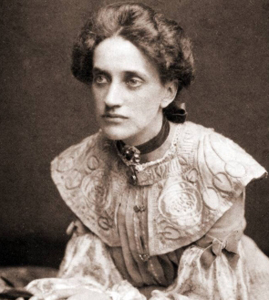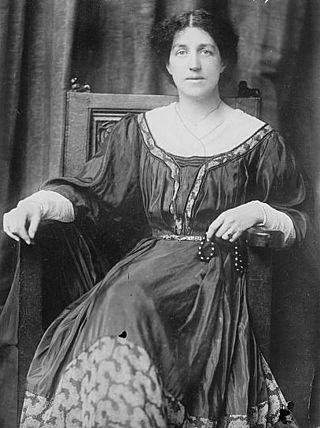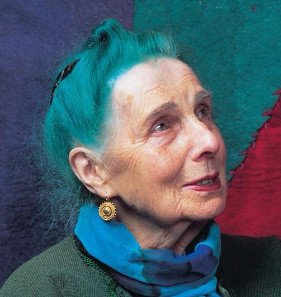
Embroidery is the art of decorating fabric or other materials using a needle to stitch thread or yarn. Embroidery may also incorporate other materials such as pearls, beads, quills, and sequins. In modern days, embroidery is usually seen on hats, clothing, blankets, and handbags. Embroidery is available in a wide variety of thread or yarn colour. It is often used to personalize gifts or clothing items.

Ann Macbeth was a British embroiderer, designer, teacher and author, a member of the Glasgow Movement and an associate of Charles Rennie Mackintosh. She was also an active suffragette and designed banners for suffragists and suffragettes movements.

Crewel embroidery, or crewelwork, is a type of surface embroidery using wool. A wide variety of different embroidery stitches are used to follow a design outline applied to the fabric. The technique is at least a thousand years old.

Needle lace is a type of lace created using a needle and thread to create hundreds of small stitches to form the lace itself.
Needlepoint is a type of canvas work, a form of embroidery in which yarn is stitched through a stiff open weave canvas. Traditionally needlepoint designs completely cover the canvas. Although needlepoint may be worked in a variety of stitches, many needlepoint designs use only a simple tent stitch and rely upon color changes in the yarn to construct the pattern. Needlepoint is the oldest form of canvas work.

Chain stitch is a sewing and embroidery technique in which a series of looped stitches form a chain-like pattern. Chain stitch is an ancient craft – examples of surviving Chinese chain stitch embroidery worked in silk thread have been dated to the Warring States period. Handmade chain stitch embroidery does not require that the needle pass through more than one layer of fabric. For this reason the stitch is an effective surface embellishment near seams on finished fabric. Because chain stitches can form flowing, curved lines, they are used in many surface embroidery styles that mimic "drawing" in thread.

Mary "May" Morris was an English artisan, embroidery designer, jeweller, socialist, and editor. She was the younger daughter of the Pre-Raphaelite artist and designer William Morris and his wife and artists' model, Jane Morris.
Leon Conrad is a British polymath: writer, story structure consultant, educator, and specialist in historic needlework techniques known particularly for historically-styled blackwork embroidery designs.
Erica Wilson was an English-born American embroidery designer based in New York, known particularly for needlepoint. She also designed wallcoverings and greeting cards. Her designs were published by Vogue and the Metropolitan Museum of Art, among others. Wilson earned the nicknames "Julia Child of embroidery" and "America's first lady of stitchery" for her work.
The Embroiderers' Guild is the UK's leading educational charity promoting embroidery. The New South Wales branch was formed in 1955.

Toye, Kenning & Spencer is a British jewellery and clothing manufacturer based at Bedworth, Warwickshire; the Jewellery Quarter, Birmingham; and Covent Garden, London.

English embroidery includes embroidery worked in England or by English people abroad from Anglo-Saxon times to the present day. The oldest surviving English embroideries include items from the early 10th century preserved in Durham Cathedral and the 11th century Bayeux Tapestry, if it was worked in England. The professional workshops of Medieval England created rich embroidery in metal thread and silk for ecclesiastical and secular uses. This style was called Opus Anglicanum or "English work", and was famous throughout Europe.

Queen Elizabeth II's coronation took place on 2 June 1953. Ordered in October 1952, her gown took eight months of research, design, workmanship, and intricate embroidery to complete. It featured the floral emblems of the countries of the United Kingdom and those of the other states within the Commonwealth of Nations, including the English Tudor rose, Scots thistle, Welsh leek, Irish shamrock, Canadian maple leaf, Australian wattle, New Zealand silver fern, South African protea, Indian lotus flower for India, the Lotus flower of Ceylon, and Pakistan's wheat, cotton, and jute.

Hand & Lock is an embroidery brand in the United Kingdom created from the merger of M Hand & Company and S Lock in 2001, and is based in Fitzrovia, London.

Magna Carta (An Embroidery) is a 2015 work by English installation artist Cornelia Parker. The artwork is an embroidered representation of the complete text and images of an online encyclopedia article for Magna Carta, as it appeared in English Wikipedia on 15 June 2014, the 799th anniversary of the document.

William George Paulson Townsend (1868–1941) was an English artist, designer, writer and editor.

Suzhou embroidery, Su embroidery or Su xiu is the embroidery created around the city of Suzhou, Jiangsu, China. It is one of the oldest embroidery techniques in the world and is the most representative type of art in Chinese embroidery. One of the well-known "four great embroideries of China" along with Cantonese embroidery, Sichuan embroidery and Xiang embroidery, Suzhou embroidery already has a history more than 2,000 years and is an important form of handicraft in the history of Chinese art and folk custom, representative of Chinese traditional folk arts. It is famous for its variety of stitches, beautiful patterns, elegant colors, and consummate craftsmanship.
Elizabeth (Bessie) Burden was a British embroiderer and teacher. She was a member of the Arts and Crafts Movement, and worked for the embroidery department of Morris, Marshall, Faulkner & Co. She was the sister of Jane Morris and sister-in-law of the artist, designer and poet, William Morris.

Constance Mildred Howard, later Constance Parker, was an English textile artist and embroiderer who had a profound impact on the development and teaching of those subjects in Britain. The Constance Howard Gallery, part of Goldsmiths, University of London, is named in her honour.
Louisa Pesel (1870–1947) was an English embroiderer, educator and textile collector. She was born in Bradford, and studied textile design at the National Art Training School, causing her to become interested in decorative stitchery. She served as the director of the Royal Hellenic School of Needlework and Lace in Athens, Greece, from 1903 to 1907. Pesel served as the first president of the Embroiderers' Guild. She produced samplers for the Victoria and Albert (V&A) Museum and cushions, kneelers, alms bags and a lectern carpet for Winchester Cathedral. She collected textiles extensively, and following her death in Winchester in 1947, her collection went to the University of Leeds.

















